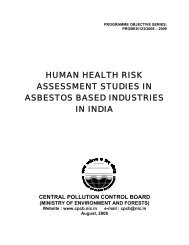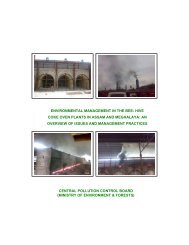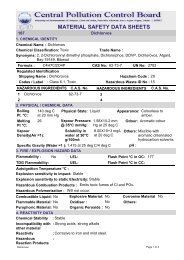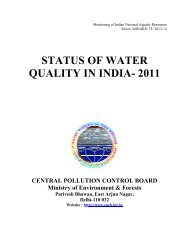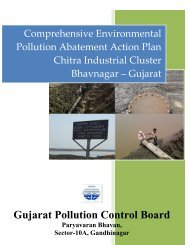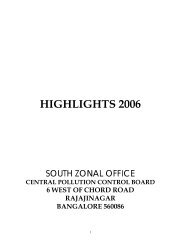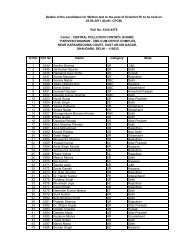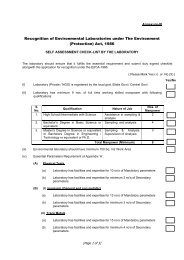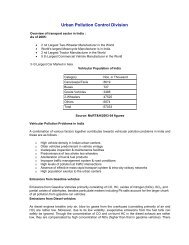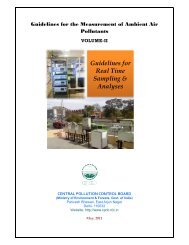Water Purification & Public Health
Water Purification & Public Health
Water Purification & Public Health
- No tags were found...
Create successful ePaper yourself
Turn your PDF publications into a flip-book with our unique Google optimized e-Paper software.
<strong>Water</strong> <strong>Purification</strong> & <strong>Public</strong> <strong>Health</strong>Dr. S.P. SinghProf. & HeadDepartment of Veterinary <strong>Public</strong> <strong>Health</strong>College of Veterinary & Animal SciencesG.B. Pant University of Agric. TechPantnagar-263 145
<strong>Water</strong>“ A clear transparent liquid, perfectlyneutral in reaction and devoid of taste orsmell”In the pure state it is composed of oxygen andhydrogen in proportion of 1:2 by volume
Concept of pure water• Pure water“ <strong>Water</strong> that is free from objectionable color, odor, taste& turbidity is called pure water• Wholesome water“ Pure water which contains adequate amount ofdissolved oxygen but no microorganisms and otherorganic pollutants and is free of microbial and chemicaltoxins is called wholesome water”
Importance of <strong>Water</strong> in body• > 90% of the weight of the newly born creature is water.• Loss of water (20%) causes instant death.• It is necessary part of a protoplasm.• The blood, lymph, gastric juice, spinal fluid are mostlycomposed of water.• Removal of waste matter from the body-Urine, perspiration & tears.• Needed for maintenance of normal body temperature.• Essential for the enzymatic activity.
Functions of <strong>Water</strong>Functions of <strong>Water</strong>• It is a universal solvent.• It is an efficient transport medium (nutrients)• Facilitates thermoregulation in body.• Helps in maintenance of blood and plasma volume– cellular osmotic pressure.• Assist in secretary and excretory functions of body– constituent of enzyme & hormonal secretions.• Valuable medium for administration of therapeutics.• Helps in propagating useful aquatic flora and fauna.• Essential for irrigation, power generation & domesticpurpose.
<strong>Water</strong> & <strong>Health</strong>• Approx. ~1.1 billion people lack access to improvedsources (WHO, 2002)–That accounts 17 % of global population– Two third of which live in Asia.• World’s population increases by 74.8 million everywateryear.• United Nations declares 2005-2015 as “<strong>Water</strong> for Life”– International Decade for Action and sets the world agenda on agreater focus on water- related issues.• Great consequence,– ~1.8 million people die every year from diarrhoeal diseases– Mostly from developing countries where 88% of diarrhoealdisease is attributed to unsafe water supply, inadequatesanitation and hygiene.
Significance of <strong>Water</strong> Hygiene• The world human population would reach8 billion by 2025.• Would require water to maintain hygiene.• <strong>Water</strong> resources are limited.• Would lead to increase in disease burdenon local communities.
Emergence & re-emergence emergence of waterborne diseases(i) Changing patterns of water use(ii) Population growth/migration(iii) Increased access to the water due to the changed lifestyle &recreational activities.(iv) <strong>Water</strong> scarcity, climate changes, disasters, & theemergencies,(v) War and Bioterrorism(vi) Increased population in the urban and peri-urban areas(vii) Increased use of agro-chemicals, antibiotics, growthpromoters, & other veterinary drugs for the production &protection of plants, animals and human.
Need for water purification• Industrial growth & development has increasedthe sewage production.• Increased flow of sewage and organic matterhas increased the BOD from 1 mg/liter (forneutral waters) to 300- 500 mg/liter (pollutedwater).• Micro-organisms present in farm and domesticeffluents are added to fresh water sources(rivers & lakes).• Dissolved salts can make water hard andunpalatable• Industrial wastes rich in intermediate products& heavy metals, etc are added to river streams.
Objectives of <strong>Water</strong> <strong>Purification</strong>• To remove color, objectionable odor and taste.• To remove dissolved gases and suspended solids.• To remove suspended and dissolved organic solids.• To remove pathogenic bacteria.• To make water safe for drinking and domestic purpose.
<strong>Water</strong> purification steps• ClarificationCoagulationFlocculationSterilization• Softening (if required)
Pure waterRaw <strong>Water</strong>ScreeningGrit ChamberPre-chlorinationAerationCoagulationFlocculationSedimentationFiltrationPost chlorinationOzonizationPH control/Stabilization
Pre-treatment• Roughing filters• Micro-strainers• Off-stream storage• Bank infiltration• Removes,– Algae, turbidity, viruses & protozoan cysts.• Variety of treatments are undertaken– Vary in their complexity, from disinfection to membranefiltration.
Roughing• Filters derived from rock or gravel• Used prior to filtration– Reduce– Turbidity - 60-90%– Coliform count -93-99.5%– Algal cell -37%– Total chlorophyll -53%• Color, organic carbon & turbidity can still be reduced bythe use of coagulants (alum).
Micro-strainers• Made of fabric meshes woven of stainless steelor polyester wires• Many large sized protozoa such as Balantidiumcoli can be removed• Smaller pathogens such as bacteria or virusescan not be removed• Reduce turbidity (5–20%) which can beenhanced by the use of coagulants (alum).
Off-stream storage• The quality of water in the ‘off-stream storage’ reservoirs that feedthe potable water source is determined by the physical, biologicaland chemical processes taking place in it.• The algal growth, influx of nitrogen, phosphorous and othercontaminants and the faecal contamination at or near surroundingsshould be limited• Attempts should be made to reduce birds. No tree.• If properly stored at off-storage reservoirs there can be significantreduction in the counts of Cryptosporidium, E.coli, Giardia, andenteroviruses.• Storage of water in divided reservoirs is better compared to singlelarge reservoir.
Bank infiltration• A process of surface water seeping from the bank or bedof a river or lake to the reduction wells of a watertreatment plant is known as ‘Bank infiltration’• Used in some of the European countries• This process reduces– Giardia,– Cryptosporidium,– Clostridia,– Bacteriophase– Certain viruses - Entero and Reoviruses.
Coagulation, flocculation & sedimentation• Used in conjunction with subsequent filtration.• Coagulation promotes the interaction of small particles to formlarger particles.• In practice, the term refers to coagulant addition (i.e. addition of asubstance that will form the hydrolysis products that causecoagulation), particle destabilization and inter-particle collisions.• Flocculation is the physical process of producing inter-particlecontacts that lead to the formation of large particles.• Sedimentation is a solid–liquid separation process, in which particlessettle under the force of gravity.• Most bacteria and protozoa can be considered as particles, and mostviruses as colloidal organic particles that are eliminated.
Coagulation• Coagulation means treatment of water with reagents so as toremove colloidal and coarse dispersed impurities (Particle that donot settle during sedimentation i.e. clay, silica or organic matter)• Most of them exist in colloidal form and develop negative chargehence did not collapse due to repulsion.• Coagulant are added which neutralises the charge on colloidalparticles. Aluminium sulphate Ferric chloride Ferric sulphate Ferrous sulphate• Types of coagulation Contact coagulation Electrochemical coagulation
Flocculation• Process of coagulation can be hastened by using certainchemicals called as flocculent.StarchSodium polyaginatePolyacrylamideCopolymer of vinyl acetateActivated silicaPAA*PAA is most widely used flocculent and it increases coagulation rate ofaluminum sulphate by 10-20 times and reduces consumption of coagulantby 2-3 times
• Conventionally, clarification refers to chemical addition,rapid mixing, flocculation and sedimentation.• When properly performed, coagulation, flocculation andsedimentation can result inconsiderable removals ofbacteria, viruses and protozoa.• However, Cryptosporidium and Giardia are found at verylow levels, and methods for their detection have limitationsuse of coagulants further helps in the reduction of turbidity.• Can be achieved by the use of iron-based coagulants– Aluminum hydroxide– Poly-aluminum chloride (PACl)• Coagulation conditions (i.e. dose, pH, temperature,alkalinity, turbidity and the level and type of natural organicmatter) affect the efficiency.
Type of filter• Single flow closed pressure filter.• Open type mechanical filter.• Horizontal closed pressure filter.• Multiple mechanism filter.• Chamber type filter.*Open type mechanical filter is commonly used in large scalepurification of drinking water.
Filtration• Removes sand, clay and other matter as well as organisms bymeans of small pore size membranes, adsorption, exchange resinsand osmosis.• Effectively remove bacteria and parasites but not viruses.• Good filters are effective against Cryptosporidia and Giardia.• Due to the inability to remove viruses, filtered water must also bechemically treated or boiled and hence many a times filtration iscombined with other chemical sterililants such as iodine (or chlorine)hence, modern filters incorporate chemical disinfection, which isusually achieved by passing water through iodine exchange resins.
Filtration processes– Diatomaceous earth– Micro-filtration- pore size 0.1 µm or more– Nano-filtration;– Reverse osmosis;– Ultra-filtration- pore size 0.01 µm or more• Filtration can act as a consistent and effective barrier for microbialpathogens.• Granular high rate media filtration is the most widely used filtrationprocess in drinking water treatment.• Under optimal conditions, a combination of coagulation, flocculation,sedimentation and granular media filtration can result better removalof protozoan pathogens with chlorine-resistant cysts.• Bag, cartridge and fibrous filters are widely used in the recent past.
Dissolved air flotation (DAF)• Bubbles are produced by reducing pressure in a waterstream saturated with air.• Rising bubbles attach to floc-particles, causing theagglomerate to float to the surface, where the materialis skimmed off.• DAF can be particularly effective for removal of algalcells and Cryptosporidium oocysts.
Precipitate lime softening• Process in which the pH of the water is increased(usually through the addition of lime or soda ash) toprecipitate high concentrations of calcium andmagnesium.• Reduction in the viability of of Giardia, viruses andcoliform bacteria is achieved.
Sterilization• Chemical methodPrecipitation : Alum, soda ash and limeAerationOzonizationChlorination• Physical method‣Boiling‣Exposure to sunlight and ultraviolet light
Disinfection of water and public health• Various disinfectants used for treatment of water to inactivatepathogenic microbes. The disinfection processes have strongbearing on the final quality of the water used for the drinkingpurpose viz.,(i) Pretreatment oxidation where in oxidants are added to water earlyin the treatment process;(ii) Primary disinfection is important as granular filter media do notremove all microbial pathogens from water(iii) Secondary disinfection employed to maintain the water qualityachieved at the treatment plant throughout the distribution systemup to the tap.
Factors– Disinfectant concentration,–Contact time,– Temperature–pH
Primary disinfection• A disinfection barrier is a common component of primarytreatment of water and is typically a chemical oxidationprocess, although ultraviolet (UV) irradiation andmembrane treatment are gaining increased attention.• Different types of disinfectant such as chlorine,monochlorine, chlorine dioxide, ozone, UV light andmixed oxidants can be used for various pathogenicmicroorganisms.
Chlorination• Plain chlorination• Pre chlorination• Post chlorination• Double chlorination• Super chlorination• Break point chlorination• Bleaching powder method
• Chlorine and silver based preparations destroymost the bacteria (e.g. V.cholerae), but are lesseffective against viruses (hepatitis A) and cysts(Giardia, amoebic cysts, and Cryptosporidia).• Chlorine alone is readily inactivated by organicmatter and its action varies with pH.• However, if used in combination with Phosphoricacid it is more effective and this combination willdestroy both Giardia and Cryptosporidia.
• For nearly 100 years of chlorination for of drinking-water hasdemonstrated the effectiveness of this process for inactivation ofmicrobial pathogens, with the notable exception of Cryptosporidium.• Certain bacteria show a high level of resistance to free chlorine.• Spore forming bacteria such as Bacillus or Clostridium are highlyresistant when disseminated as spores.• Acid-fast and partially acid-fast bacteria such as Mycobacterium andNocardia can also be highly resistant to chlorine disinfection.• Since Gram-positive bacteria have thicker walls than Gram-negativeones the pathogenic group that survives chlorination are grampositive as well as acid fast pathogens.• Enteric viruses are generally more resistant to free chlorine thanenteric bacteria due to the protective nature of the particle surface(Coxsackie A2).
Secondary Disinfection• The purpose of a secondary disinfectant is to maintainthe water quality achieved at the treatment plantthroughout the distribution system up to the tap.• Provides a final partial barrier against microbialcontamination and serves to control bacterial growth.• The practice of residual disinfection has becomecontroversial, with some opponents arguing that ifbiological stability is achieved and the system is wellmaintained, the disinfectant is unnecessary.
Conclusions• The drinking water should not only be visibly clean but is shouldalso be wholesome and free from microbial as well as non-microbialcontaminants.• The water purification is never an accident, stringent exercises needto be undertaken so as to keep it away from the contaminants.• Various processes used for the purification of water suffer from oneor the other lacunae; so we need to use a composite system thatcan enhanced safety.• In the industries where water is used directly or indirectly for thepreparation of food, HACCP need to be implemented so as to reducecontamination of water at any step.• The source of water should be kept clean and suitable primarypurification system should be employed as per therecommendations of the competent authority.• In case there is a need for the secondary disinfection, strategyneeds to be defined and then implemented so as to keep thepathogens away from the water distribution system.• Assurance of safe water to the consumers.
Thanks



